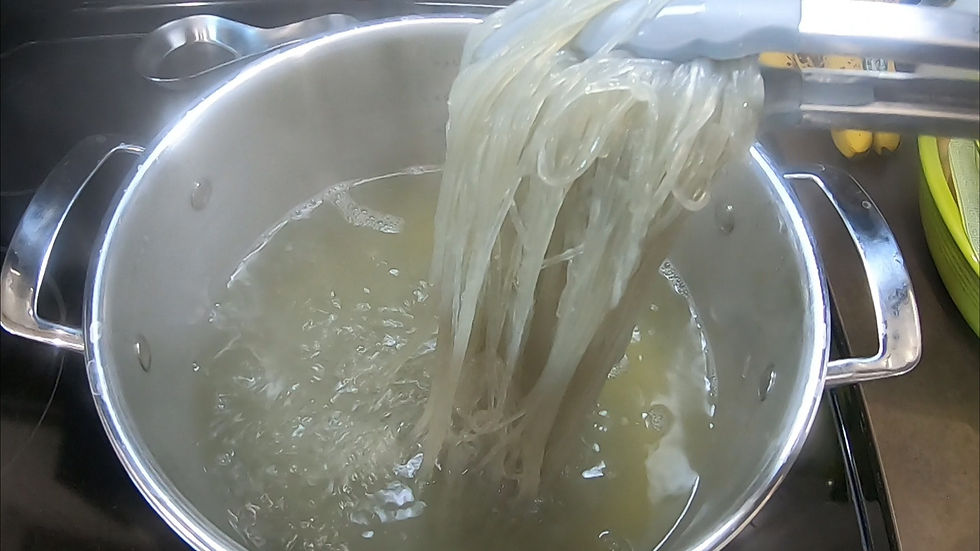Korean Glass Noodles (Japchae)
- Mike Grubb
- Jun 18, 2024
- 3 min read
Korean cuisine is a treasure trove of flavors, textures, and traditions. Among its many delicacies, Japchae stands out for its unique composition and delightful taste. Whether you're a seasoned foodie or curious newcomer, exploring Japchae can be a journey like no other. In this article, we delve into the vibrant world of Korean glass noodles, examining their history, preparation, and cultural significance...Let's Get Cooking!

Historical Background
Japchae, which translates to "mixed vegetables," originally emerged in the 17th century during the reign of King Gwanghaegun. The dish was first introduced as a royal delicacy by Yi Chung, who created it for a banquet. Its delightful combination of vegetables and noodles won the king's favor, securing its place in Korean culinary history.
Evolution Over Time
Over the centuries, japchae has evolved from a royal dish to a popular household staple. Initially made without noodles, the dish later incorporated dangmyeon—sweet potato starch noodles—adding a chewy texture that perfectly complements the assorted vegetables and meat.
Ingredients: The Heart and Soul of Japchae
One of the most fascinating aspects of japchae is its diverse array of ingredients. Each component brings a unique flavor and nutritional benefit to the table.

The Star: Sweet Potato Starch Noodles
The key ingredient in japchae is dangmyeon, or sweet potato starch noodles. These translucent noodles have a smooth, slightly chewy texture that absorbs the flavors of the surrounding ingredients beautifully.
Appearance: Translucent and glassy when cooked.
Taste: Mild and neutral, enhancing the flavors of accompanying ingredients.
Nutrition: Gluten-free and low in calories.
Vegetables Galore
Japchae is a vegetable-rich dish, often featuring a vibrant mix of carrots, spinach, bell peppers, and mushrooms.
Carrots and Bell Peppers: Add crunch and a touch of sweetness.
Spinach: Provides a soft texture and a touch of bitterness.
Mushrooms: Bring an earthy, umami flavor to the mix.
Protein Choices
While vegetables are central to japchae, proteins such as beef, chicken, or tofu can be added to enhance the dish's nutritional content.
Beef: Thinly sliced, marinated beef adds a savory richness and protein boost.
Chicken: Offers a leaner protein option while maintaining the savory profile.
Tofu: A great vegetarian alternative, providing protein while soaking up the flavors.
Sauce and Seasoning
The distinct flavor of japchae comes from its sauce—a harmonious blend of soy sauce, sesame oil, garlic, and sugar.
Soy Sauce: Provides the salty, umami base.
Sesame Oil: Adds a fragrant nuttiness.
Garlic: Infuses the dish with aromatic depth.
Sugar: Balances the savory elements with a hint of sweetness.
The Art of Making Japchae
Creating japchae is a step-by-step process that combines precision and creativity. Here’s how you can make this delicious dish at home.
Preparation Steps
Marinate the Beef: Combine the marinade ingredients with the thin-sliced beef.

Create the Sauce: Add the sauce ingredients to a small bowl and mix well.

Prepare the Vegetables: Julienne the carrots, bell peppers, and onion.

Stir-fry the Vegetables: In a large pan, stir-fry the julienned vegetables until they are tender yet crisp.

Blanch the Spinach: Quickly add the spinach to salted, boiling water for 10-15 seconds and immediately transfer to an ice bath.

Prepare the Noodles: Add the noodles to the same salted water you cooked the spinach in for extra flavor. Boil for 4-6 minutes, until softened.

Cook the Beef: Stir-fry until cooked through.

Combine and Season: In a big bowl, mix the cooked noodles, vegetables, and protein. Add the sauce ingredients and toss everything to ensure it's evenly coated.

Tips for Perfect Japchae
Balance the Flavors: Taste and adjust the seasoning to ensure a harmonious blend of salty, sweet, and savory.
Texture Matters: Cook the noodles and vegetables to the right texture—noodles should be chewy, and vegetables should retain some crunch.
Presentation: Serve japchae beautifully plated, showcasing its array of colors.
Cultural Significance and Modern Variations
Japchae holds a special place in Korean culture, often prepared for special occasions and celebrations.
Traditional Celebrations
Japchae is a common feature during Korean holidays and celebrations, such as Lunar New Year (Seollal) and Harvest Festival (Chuseok). Its vibrant presentation and rich flavors symbolize abundance and good fortune.
Contemporary Twists
While traditional japchae remains popular, modern variations have emerged, reflecting contemporary tastes and dietary preferences.
Vegetarian and Vegan Japchae: With tofu and a variety of mushrooms.
Spicy Japchae: Adding gochujang (Korean chili paste) for a fiery kick.
Fusion Japchae: Incorporating ingredients from other cuisines, such as adding a sauce inspired by Japanese or Thai flavors.
Japchae is a delightful dish that encapsulates the essence of Korean cuisine. Its combination of chewy glass noodles, vibrant vegetables, and savory sauce creates a symphony of flavors and textures that is hard to resist. Whether you’re preparing it for a festive occasion or a simple family dinner, japchae promises a culinary experience that is both satisfying and enriching. Ready to try making japchae at home? Get the freshest ingredients, follow the steps, and treat yourself to a taste of Korea...Just Keep Cooking!
KOREAN GLASS NOODLES (JAPCHAE)







Comments